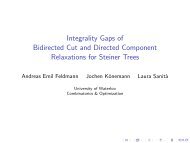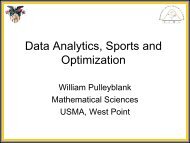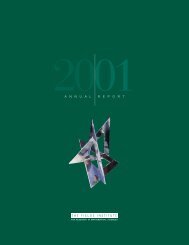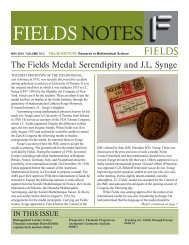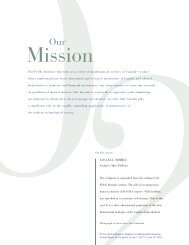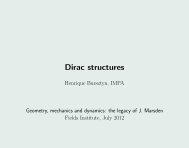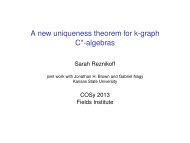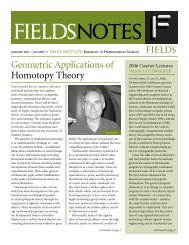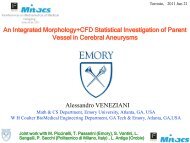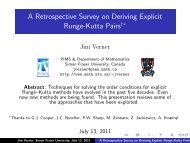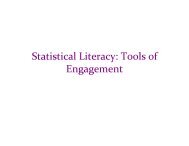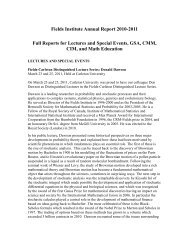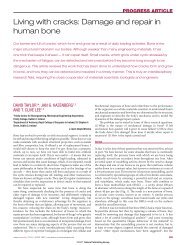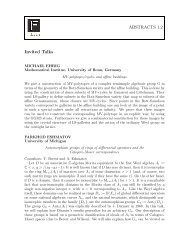Annual Report 2005 - Fields Institute - University of Toronto
Annual Report 2005 - Fields Institute - University of Toronto
Annual Report 2005 - Fields Institute - University of Toronto
Create successful ePaper yourself
Turn your PDF publications into a flip-book with our unique Google optimized e-Paper software.
the property (T) in 2001.)<br />
The workshop was attended by 33 registered participants,<br />
including 18 graduate students and postdocs, and was supported<br />
by the <strong>Fields</strong> <strong>Institute</strong> and the <strong>University</strong> <strong>of</strong> Ottawa.<br />
Bachir Bekka introduced Property (T) in his first lecture<br />
and gave applications <strong>of</strong> it in his second lecture. In the<br />
third, he presented some new developments <strong>of</strong> the theory.<br />
Alain Valette’s three lectures centered on the relations<br />
between Property (T) and affine actions. In particular, in<br />
his first lecture he showed that Property (T) is equivalent<br />
to the fixed point property for affine actions (Delorme-<br />
Guichardet theorem). In his second lecture, he gave<br />
Shalom’s characterization <strong>of</strong> property (T) and in the third<br />
he linked finite presentability and property (T).<br />
Claire Anantharaman presented the links between von<br />
Neumann algebras and Property (T). In her first lecture,<br />
she presented the basic definitions <strong>of</strong> type II 1 -factors and<br />
gave examples constructed from discrete groups and discrete<br />
measured equivalence relations. In her second lecture,<br />
she introduced Property (T) for type II 1 factors and showed<br />
in particular that the fundamental group <strong>of</strong> such a factor<br />
is countable. In her third talk, Claire introduced Relative<br />
property (T), Haagerup approximation property (H) and<br />
the notion <strong>of</strong> (HT) Cartan subalgebra. Using these notions,<br />
she then presented the recent developments <strong>of</strong> the theory <strong>of</strong><br />
type II 1 von Neumann factors.<br />
At the first short communications session on August 25,<br />
Talia Farnos gave a talk: New examples <strong>of</strong> group pairs with<br />
Kazhdan’s Relative Property (T). The result she presented<br />
is very interesting due to the scarcity <strong>of</strong> examples <strong>of</strong> group<br />
pairs with Kazhdan’s Relative Property (T).<br />
During the second short communications session on<br />
August 26, Stefaan Vaes presented a new pro<strong>of</strong> <strong>of</strong> Nicoara,<br />
Popa, and Sasykk <strong>of</strong> Osawa’s result on the non-existence <strong>of</strong><br />
a universal II 1 factor: a (separable) II 1 factor that contains<br />
any (separable) II 1 factor as a subfactor.<br />
In the last session <strong>of</strong> the workshop, the main speakers presented<br />
a list <strong>of</strong> very interesting open problems.<br />
Overall, the workshop was a remarkably coherent event.<br />
The main speakers did a marvelous job not only in the<br />
quality <strong>of</strong> their lectures but also in the coordination <strong>of</strong> the<br />
materials they presented. Its impact on the directions <strong>of</strong><br />
research pursued by younger attendees should be considerable.<br />
G e n e r a l S c i e n t i f i c A c t i v i t i e s<br />
Speakers:<br />
Bachir Bekka (Metz)<br />
Introduction to Property (T)<br />
Applications <strong>of</strong> Property (T)<br />
Some new developments<br />
Claire Anantharaman-Delaroche (Orléans)<br />
Type II 1 factors in relation with group and ergodic theory<br />
Property (T) for type II 1 factors<br />
(HT) type II1 factors<br />
Talia Fernos (UIC)<br />
New examples <strong>of</strong> group pairs with Kazhdan’s Relative Property<br />
(T)<br />
Stefaan Vaes (CNRS, Paris)<br />
There is no universal II 1 factor<br />
Alain Valette (Neuchâtel)<br />
Property (T) and affine actions I, II, and III<br />
Mini-symposium on Influenza: Models and Data<br />
September 8, 2004<br />
Held at the <strong>Fields</strong> <strong>Institute</strong><br />
Organizer: David Earn (McMaster)<br />
Picture: Influenza_Earn.jpeg<br />
Caption: David Earn<br />
On the afternoon <strong>of</strong> September 8, 2004, the <strong>Fields</strong> <strong>Institute</strong><br />
hosted a mini-symposium on Influenza: Models and Data.<br />
An audience <strong>of</strong> about 40 participants heard presentations<br />
from five applied mathematicians and mathematical biologists<br />
who have been working together in an effort to make<br />
progress on understanding the epidemiology <strong>of</strong> influenza.<br />
David Earn<br />
<strong>Fields</strong> <strong>Institute</strong> <strong>2005</strong> ANNUAL REPORT 63



